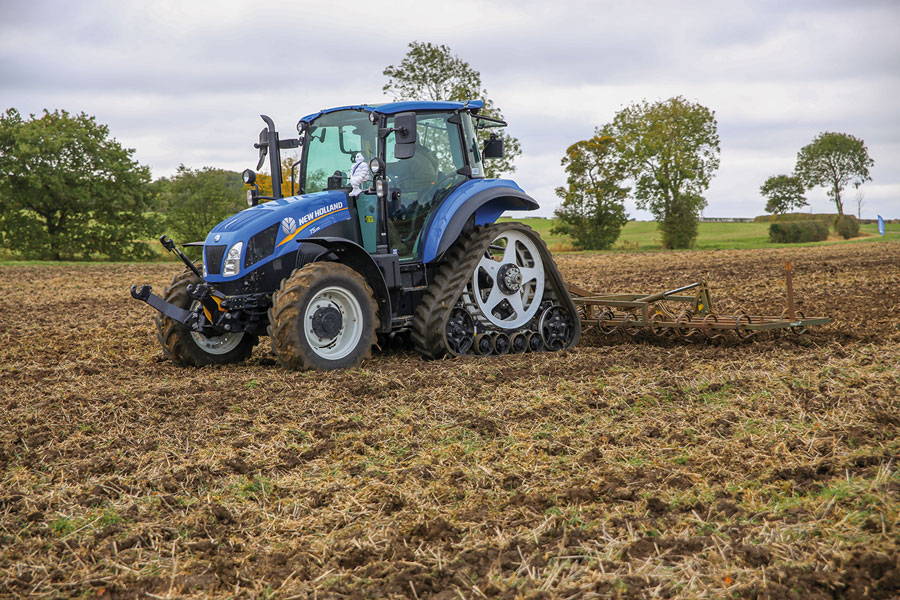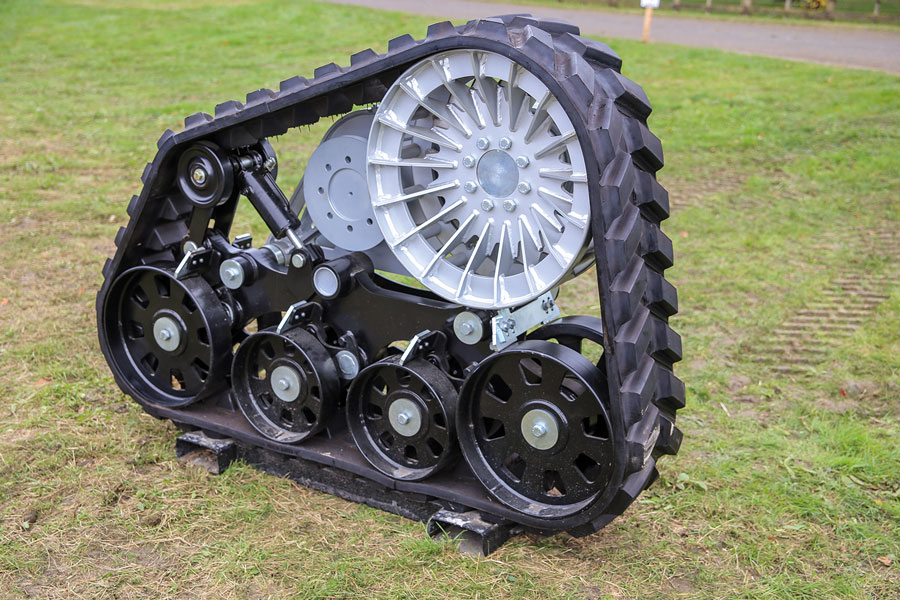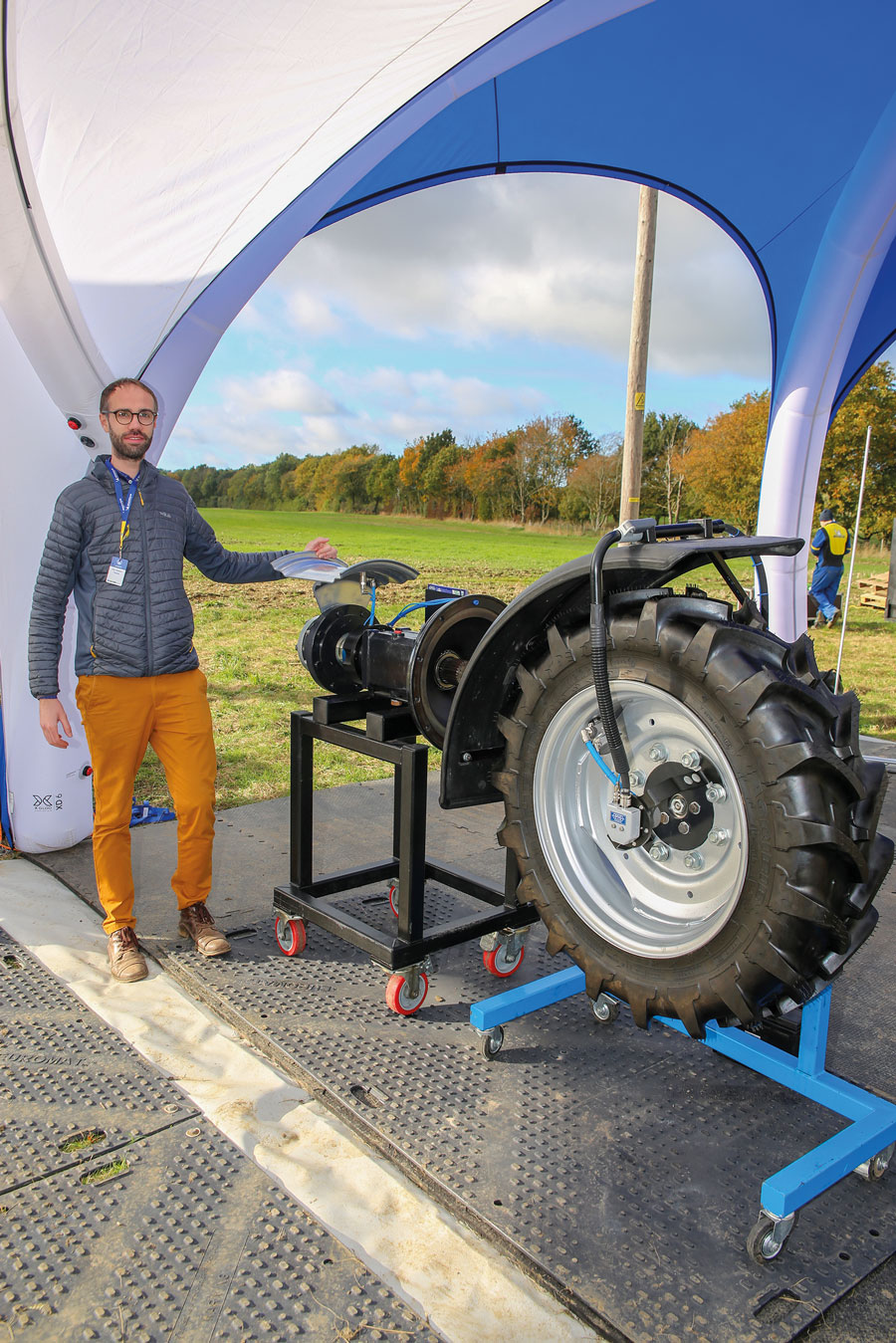Ground protection and traction solutions demonstrated
27th December 2021
European tour of tyre and track solutions from Michelin visited the UK during November, providing an opportunity for dealers and customers to learn about the latest products and how to get the best from them. David Williams was there.
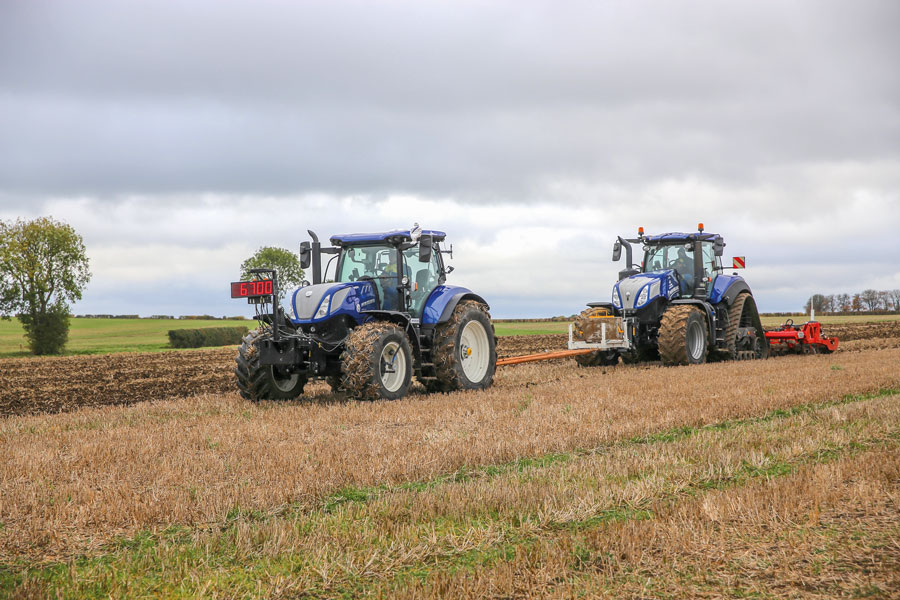
Theory is fine – but a demonstration by Michelin proved benefits of higher specification tyres operated at the correct pressures.
The demonstration, on a farm near Cambridge, included Michelin IF and VF tyres fitted to New Holland tractors as well as Camso tracks on a New Holland T8 SmartTrax. There was also a smaller New Holland T5 tractor with a Camso half-track system which is available as an option now in parts of Europe.
Worth the extra?
Opting for premium tyres featuring the latest technology is increasingly seen by farmers and contractors as an investment rather than a cost, with benefits including reduced compaction and ground damage, increased traction, and a long working life. Many dealer open days and working demonstrations feature representatives from major tyre manufacturers available to offer advice and guidance on the most suitable tyres for a task.
As well as providing information for users, the Michelin event backed up the advice by demonstrating improvements in performance by adopting best practice.
Standard, IF and VF
VF or Very High Flexion tyres operate at 20% less pressure, or carry 20% more load at the same inflation pressure, than IF (Improved Flexion) tyres.
IF tyres operate at 20% less pressure or carry 20% more load at the same pressure as standard radial tyres, so there is a significant theoretical advantage to specifying IF or VF tyres for arable field operations as the load can be spread over a larger surface area.
Head-to-head test
Two identical New Holland T7-270 HD tractors were used for the test – both with rear tyres of the maximum 1.95m diameter recommended by the manufacturer.
One was on VF 710/60R42 rear, and VF 600/60R30 fronts from Michelin’s AxioBib 2 series and had a PTG Central Tyre Inflation System (CTIS). Air was supplied from the tractor’s air brake compressor and Isobus control allowed tyre pressure setting and adjustment from the cab.
The second tractor had 650/65R42 rear, and 540/65R30 front MultiBib standard radial tyres.
The two tractors were ballasted so that the weight distribution was 4,560kg on the front axle and 7,800kg on the rear, resulting in a 37%/63% split. Michelin said this corresponded to a typical field situation.
Benefits of CTIS
For the first test the tractor with VF tyres and the CTIS was linked by a cable from its drawbar to the front of a New Holland T8 SmartTrax with a rear cultivator (see header pic). The T8 acted as a brake tractor to ensure a constant load was applied and maintained. The T7 wheels were set to run slightly faster to increase the tractive effort, ensuring that even as changing ground conditions affected the draft needed to pull the cultivator, the tractive effort remained constant.
A drawbar sensor measured the tractive effort produced by the lead tractor which was applied to the second tractor through the cable. An external screen displayed the tractive effort in kg.
Pressure vs traction
For the test – the T8 brake tractor was set to travel at 3.6kph and the tractor being tested was set to travel at 4.6kph.
Although VF tyres can operate at high travel speeds at relatively low pressures for limited periods, for frequent road work or longer journeys increasing the inflation pressure reduces rolling resistance, extends the working life and optimises ride quality.
For the first run, the tyres were set at road pressures of 1.1 bar at the front, and 1.0 bar at the rear.
For the second run, recommended pressures for field work were set – 0.7 bar at the rear and 0.6 bar at the front. Pressures were reduced from the cab through the CTIS system just by touching the display.
Results
The first run at road pressures achieved an average 6,800kg tractive effort. The second run, at lower field pressures, achieved 8,000kg.
This revealed that operating the VF tyres at the lower pressures recommended for field work through the CTIS helps improve traction by 17%.
Michelin suggests there are two ways to interpret the benefit:
At the same tractive effort, a tractor with UltraFlex VF tyres and CTIS will slip less and consume less fuel compared to standard technology tyres.
At the same slippage rate, the tractor with UltraFlex VF tyres could pull wider implements than a tractor with standard technology tyres, resulting in improved work rates and productivity. 1,000kg of tractive effort is approximately equivalent to an extra metre of implement width, so time could be saved using a tool 1–2m wider which would also reduce soil damage through fewer wheelings.
Michelin said that the bulldozing effect and increased rolling resistance due to creating a 10cm rut is similar to constantly climbing a 10% slope, so fuel savings through reduced rutting are significant.
For those currently using standard tyres who rarely travel on the road, upgrading to Michelin UltraFlex VF tyres would offer the benefits of the configuration used for the second test. Therefore, when replacing tyres, the additional productivity is worth bearing in mind.
For farms and contractors alternating between field and road work then investing in CTIS will quickly provide returns due to increased productivity, fuel savings and tyre life.
For users spending most of their time on the road, then road tyres operating at higher pressures such as the RoadBib might be a better option.
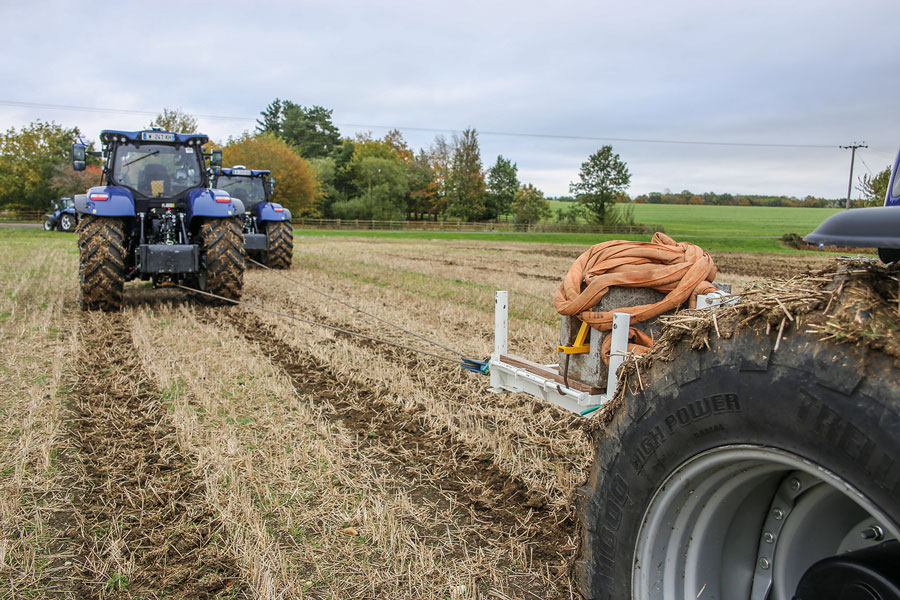
For the second demonstration, two similar tractors with different tyres and pressures were attached by cables running through a pulley to the brake tractor. The relative positions of the two lead tractors were monitored, and the one with VF tyres at field pressures clearly gained an advantage over the machine on standard tyres.
Second test – alternative tyres
The second test used both T7 tractors – one
with the previous VF tyres and the other with 650/65R42 rear, and 540/65R30 front MultiBib standard technology tyres.
Michelin used this configuration to demonstrate performance with typical tyres chosen by UK farmers for a 200hp tractor, and to show why the tyres are less suitable for the larger T7 with 240hp, compared to the VF alternative.
The tractors were set up with identical weight distribution – 4,560kg at the front and 7,800kg at the rear.
The T8 SmartTrax was used again to provide a constant load. A cable was passed through a pulley connection at the front of the T8, and the cable ends were attached to the drawbars of the two T7 tractors which were positioned side by side in front of the T8. The two T7s were set to maintain identical wheel speeds, and the objective was to provide a visual indication of the extra tractive effort produced by VF tyres by monitoring the relative positions of the two leading tractors as the brake tractor travelled a set distance.
The VF AxioBib 2 tyres were inflated to field operating pressures of 0.7 bar at the rear and 0.6 bar at the front. The standard MultiBib tyres were inflated to pressures typically selected by UK farmers – 1.6 bar (23psi) front and rear.
The demonstration made it immediately obvious that the tractor with VF tyres had more pulling power, as the T7 on standard tyres fell further behind. This resulted from the VF tyres’ larger footprint and additional traction.
Soil protection
The demonstration also highlighted the difference in footprint between the standard MultiBib tyre, the AxioBib 2 VF tyres at road pressures, and the AxioBib 2 VF tyres set at field pressures.
The standard tyres were again set at 1.6 bar, and the VF 710/60R42 AxioBib 2 were set first at higher 1.1 bar pressures for road work, then at 0.7 bar for field work. With a load on each tyre of 3,900kg the tractors were driven on to a sand pit and stopped. Powder was spread around the carcase and treads. When the tractor was moved off the sand, then the area highlighted by the light powder showed where the tyre rubber had not made contact with the ground.
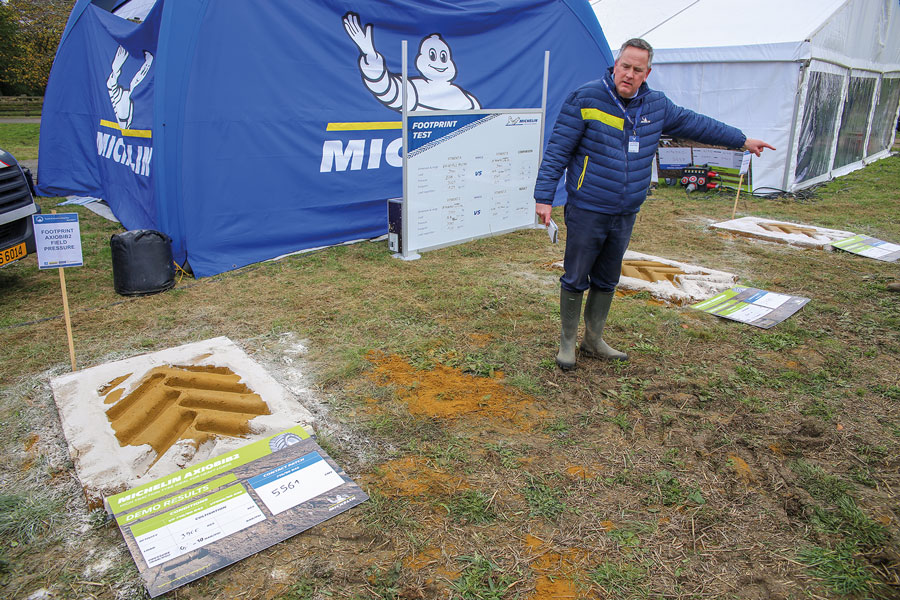
Tom Saunders explains the significance of different contact areas achieved.
Results
| Fitment | A – 650/65 R42 MULTIBIB | B – VF710/60 R42 AxioBib 2 + CTIS PTG – road pressure | C – VF710/60 R42 AxioBib 2 + CTIS PTG – field pressure |
| Weight on each tyre | 3,900kg | 3,900kg | 3,900kg |
| Inflation pressure | 1,6b (23 Psi) | 1,1b (16 Psi) | 0,7b (10 Psi) |
| Footprint | 3,021 cm2 | 3,780 cm2 | 5,561 cm2 |
| Load repartition | 1,29 kg/cm2 | 1,03 kg/cm2 | 0,7 kg/cm2 |
Comparing the results of the tractive force demonstration with the footprint measurement confirmed corresponding benefits – that the larger the ground contact area – the lower the ground pressure, and the more grip and traction was available.
Stressed soil
A further test indicating pressure exerted through soil also produced interesting results. Probes with rubber tubes were placed approximately 20cm below the surface. When the tractor drove across the soil over the sensors, the probes were compressed, and the pressure was measured. The results clearly showed that reducing tyre inflation pressures resulted in lower pressure exerted on the probes, and the soil was under less stress.
Extra profits?
Trials by Harper Adams University approximately 10 years ago compared effects of operating machines on UltraFlex VF tyres on one area, while machines on an adjacent area were on standard tyres. The yield on the field area farmed using UltraFlex VF tyres was 4% higher than the area where standard tyres were used.
Michelin stresses that to achieve improvements in soil structure and results, a complete vehicle fleet management approach is needed, with tyre equipment and pressures optimised.
However, if 4% extra yield can be achieved over 100ha, then with wheat priced at £170/t, and a starting yield of 7t/ha, then 28t extra will add £4,760 to the turnover.
Rubber tracks
Track manufacturer Camso is owned by Michelin, and the Michelin European tour was an ideal opportunity to display the Camso CTS half-track system fitted to a New Holland T5. For tractors of 90–150hp and covering the 4-cyl and small 6-cyl market segment, the bolt-on track units can be fitted to existing tractors and are also available as an approved New Holland option. The power rating means pressed steel wheels and steel idler and mid rollers are used rather than heavier cast versions. The T5 UTL SmartTrax has an overall width between 1.5–2.0m depending on the width of tracks specified, which are available in 300, 340 and 450mm widths.
The track assemblies pivot up to 25 degrees forwards and back allowing maximum ground contact to be maintained. Maintenance is minimal with only four grease nipples requiring attention every two days. New Holland sees a potential market replacing old steel track crawlers, and the rubber tracks and modern cab offer greater comfort while the tracks can also be removed and replaced by wheels. The track option is available this year, and New Holland was keen to assess the potential market for the innovation which costs £20K–£25K, during the tour.
Camso also displayed its larger CTS half-tracks, suitable for fitting in pairs or as a set of four on larger tractors up to 250hp such as New Holland T7 and T8 models. With Isomount suspension, they allow speeds up to 40kph where standard wheel tractors would also travel at 40kph.
Supply and fit UK
TractAir Ltd, based in Lincolnshire, imports and installs the PTG tyre inflation system in the UK.
“The only way to get the best performance from tyres is to run them at the right pressures,” explained TractAir senior design engineer, Alan Wattam (above). “Reduced pressures allow the operator to get so much more from tractors in the field. Less and shallower compaction, fuel savings, reduced tyre wear, improved soil drainage, a longer tyre working life and many more benefits, but they also need to run at suitable pressures at higher speeds on the road.”
Alan stressed that reasons tyres are not run at optimum pressures include – time taken to check and adjust, lack of an air supply, advantages of correct inflation pressures not being understood, and a lack of interest if the user isn’t paying for fuel.”
He said the TractAir CTIS is fully integrated and convenient to use. Pipework to the front wheels is external, but for situations where it might be damaged it can be quickly disconnected without tools and the front air lines stored safely on the mudguards. If damage does occur while the lines are connected, then no air can escape from the tyres.
Most rear wheels have an internal air supply through the bar axle. The latest New Holland T7 tractors are being supplied from the factory with holes already drilled into the axle, ready to fit the inflation system as demand is increasing so rapidly.
Pressure control is through the tractor’s main terminal with an Isobus link, or through a separate RDS Digital display. The PTG system is supplied and fitted by TractAir at a cost of £10,000–£15,000.
Air-less wheel
Michelin’s X Tweel airless radial tyre, which uses poly-resin spokes to carry the load rather than air pressure, was also demonstrated. Michelin operational marketing manager, Chris Dolman (below) said the Tweel is available currently in sizes up to 18 inches and is proving particularly popular for use on skid-steer loaders where frequent punctures in conventional tyres are a problem. The technology is also being tested for use on cars and for other applications, and working life is up to three times that of conventional tyres. FG

